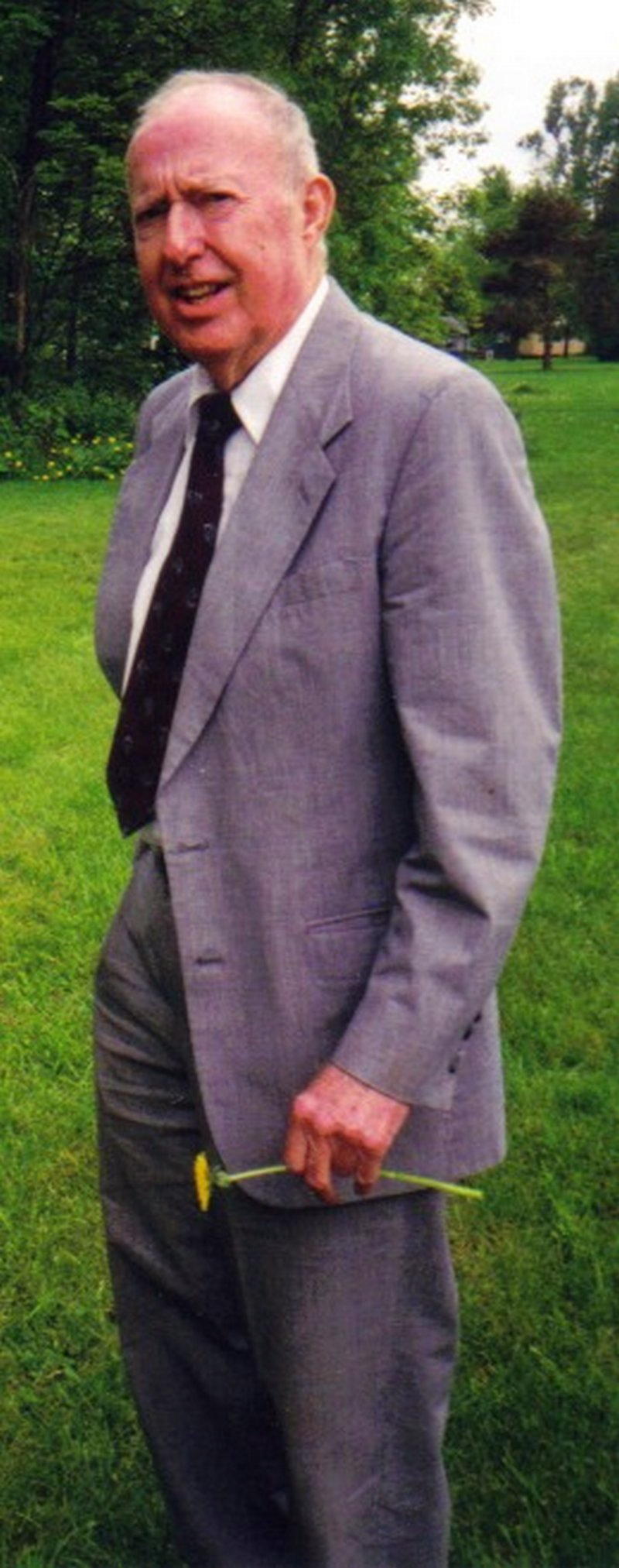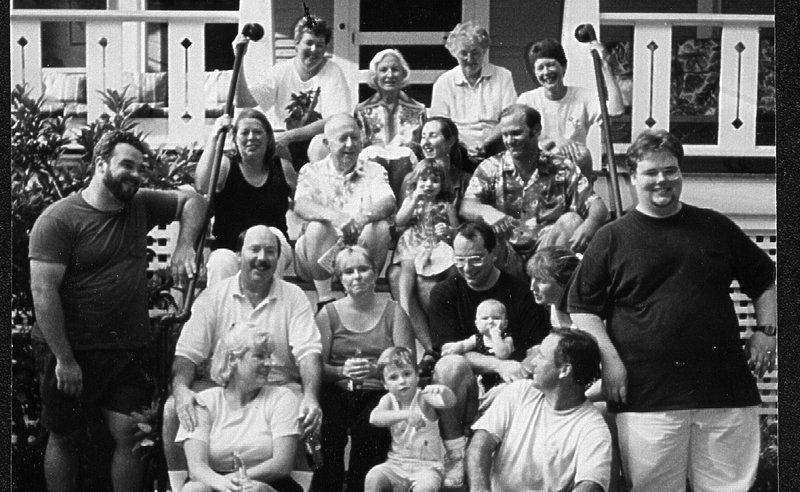2002 AND MY PHILADELPHIA STORY
Unlike 2001 and 2003, the year 2002 was a quiet
one, with only two events worthy of telling. It started off quite
early with my attendance at Tom Henney's funeral. He died from
prostate cancer on January 8th, the second cancer victim in our
family — Clyde Balch being the first in 1991 and wife Mary Jo
being the third in 2003. The year practically ended with Will's
presentation, "The Genesis of NASA RECON" (my contract with
NASA to implement a two-month test of a computerized remote access to
their 200,000 plus published documents on all phases of aerospace
technology at three NASA centers, which I briefly describe in Chapter
16, to the American Society for Information Science at its annual
meeting, called Information, Connections, and Community, in
Philadelphia November 18-21, to which he took me as his Exhibit A
(see below).
Tom Henney's Death and Funeral

 Tom
died Jan. 8, 2002. Since Margery was my favorite niece and Morgan was
her brother, it was natural for the two of us to travel to Washington
together in my car to attend the funeral of Tom Henney (see left).
The photo on the right was taken on Tom's birthday, August 22, 1998,
and shows many of his descendants. (From left to right,): (top
row) Margie Henney, Minerva Martin, Margery, Glenda Parker; (next
row down) Kathie Hummel, Tom Henney, Barbara Wright Henney
holding Alexandra LaRouche, Dana Wright; (third row down) Bill
Henney, Genie Henney LaRouche, Gunnar Hempel holding Melanie Hempel,
Patti Henney Hempel; (bottom row Jo Anne Henney, Nathaniel
LaRouche, Chuck Henney. Glenn LaRouche is standing by the left rail,
and Isaac Hummel is standing by the right rail.
Tom
died Jan. 8, 2002. Since Margery was my favorite niece and Morgan was
her brother, it was natural for the two of us to travel to Washington
together in my car to attend the funeral of Tom Henney (see left).
The photo on the right was taken on Tom's birthday, August 22, 1998,
and shows many of his descendants. (From left to right,): (top
row) Margie Henney, Minerva Martin, Margery, Glenda Parker; (next
row down) Kathie Hummel, Tom Henney, Barbara Wright Henney
holding Alexandra LaRouche, Dana Wright; (third row down) Bill
Henney, Genie Henney LaRouche, Gunnar Hempel holding Melanie Hempel,
Patti Henney Hempel; (bottom row Jo Anne Henney, Nathaniel
LaRouche, Chuck Henney. Glenn LaRouche is standing by the left rail,
and Isaac Hummel is standing by the right rail.
Even though
Washington can be quite wintry in January, we arrived during a warm
spell, and didn't have to suffer from the North's cold and snow that
keeps me in Florida. Margery took her loss very well, as it was
apparent months before that the cancer would win out eventually.
For our part the visit provided both of us, I believe, the
first time in many years that we would see that big family all
totgether.
The next major event was the birth of my second
great-granddaughter, Evynn Anne, on May 14th.
Preparation for My Seminar
As related more fully in the next chapter, I spent
most of 2002 in researching and writing the text for a seminar which
would describe both the scientific and Biblical views of how the
universe, the earth, and life on earth originated and developed. It
emerged as three presentations of two hours each, alternating between
20-minute sections of appropriate videos and 20 minutes of
illustrated lecture. Since I found little interest here in the United
States, I decided to take it to South Africa for two months in the
following year
My Philadelphia Story -- The Genesis of NASA RECON
We flew into Philadelphia on November 17th and
went directly to our hotel, which was about a mile from the
conference hall. It was typical November weather, moderately cold and
rainy. I remember well the next morning as we walked to the
conference in a light drizzle, as taxis were scarce. I had so much
trouble with shortness of breath that we didn't try that again.
Will's paper was scheduled for the second day (the 19th), but I
believe we attended all four days. He paid all my expenses.
The
full text of his paper, as published in the proceedings of the
conference, is given as Appendix A at the end of this DVD. Here all I
want to do is to describe our trip and summarize his presentation. I
will show you the picture of me from his paper as I was in
1966.
After a short abstract, he dives into a lengthy
discussion of several books and papers which discussed efforts of
many laboratories to design and develop on-line bibliographic
retrieval systems, in the period 1964-1966, then followed this with
descriptions of a half dozen such systems.
 Then
he introduced me and gave a lengthy description of my computer
experiences up to this point in my life. He then gave considerable
detail of the formation of the Bunker-Ramo Corporation of which
Teleregister was a component, followed by the way in which Dr. Simon
Ramo (the "R" of TRW) became aware of NASA's interest in
remote access to its huge library of aerospace literature. I had
transferred from Norwalk to the Los Angeles area, where part of
Bunker-Ramo was located, and given the mission of developing
commercial applications of the expertise of this division, which came
out of TRW and had worked exclusively for Uncle Sam.
Then
he introduced me and gave a lengthy description of my computer
experiences up to this point in my life. He then gave considerable
detail of the formation of the Bunker-Ramo Corporation of which
Teleregister was a component, followed by the way in which Dr. Simon
Ramo (the "R" of TRW) became aware of NASA's interest in
remote access to its huge library of aerospace literature. I had
transferred from Norwalk to the Los Angeles area, where part of
Bunker-Ramo was located, and given the mission of developing
commercial applications of the expertise of this division, which came
out of TRW and had worked exclusively for Uncle Sam.
Since
Teleregister had majored in remote console operations in brokerage,
airline seat reservations, and banking, I thought a logical expansion
of this business was to have a universal remote console system that
could handle all of the present applications and many new ones. I
prepared a paper called the "Bunker-Ramo Direct Electronic
Library."
Will described this in detail and then
explained how NASA became aware of this document, liked it, and put
out a bid for any firm to implement a trial in three of NASA's
centers of a system, which they called "NASA RECON," to
remotely access their library of over 200,000 documents. He then
described how we won this contract, my part in implementing it,
quoting "My Biography" as well as the proposal itself. He
goes on to describe the execution of the contract, the failure of
Bunker-Ramo's eastern division to fully implement the proposal and
the resulting lack-luster performance of the test. Nevertheless NASA
was pleased with the results and wanted to continue the test. Will
again quotes my book (see Chapter
16) to tell how Milt Mohr, now CEO of Bunker-Ramo, wanted no
more of it and doubled the charges for rental of the equipment used
which NASA refused to pay. He then invited me to leave the
company.
Will ended up by a section he called "In
Retrospect", which he concluded with this quote, "The
Direct Electronic Laboratory showed NASA what was possible and
established a standard that NASA expected all future systems to meet.
In May of 1967 Mitchell became the Director of the Operating
Computing Branch at Goddard Space Center, and just before he retired
four years later he had the opportunity to use the DIALOG version of
RECON. He easily understood the system and recognized many features
that he thought (mistakenly) that he had originated. He never
realized how much duplicative design work in online retrieval was
going on outside his view during the two years he devoted to the
Direct Electronic Library."
Go to next chapter
Return to Table of Contents.

 Tom
died Jan. 8, 2002. Since Margery was my favorite niece and Morgan was
her brother, it was natural for the two of us to travel to Washington
together in my car to attend the funeral of Tom Henney (see left).
The photo on the right was taken on Tom's birthday, August 22, 1998,
and shows many of his descendants. (From left to right,): (top
row) Margie Henney, Minerva Martin, Margery, Glenda Parker; (next
row down) Kathie Hummel, Tom Henney, Barbara Wright Henney
holding Alexandra LaRouche, Dana Wright; (third row down) Bill
Henney, Genie Henney LaRouche, Gunnar Hempel holding Melanie Hempel,
Patti Henney Hempel; (bottom row Jo Anne Henney, Nathaniel
LaRouche, Chuck Henney. Glenn LaRouche is standing by the left rail,
and Isaac Hummel is standing by the right rail.
Tom
died Jan. 8, 2002. Since Margery was my favorite niece and Morgan was
her brother, it was natural for the two of us to travel to Washington
together in my car to attend the funeral of Tom Henney (see left).
The photo on the right was taken on Tom's birthday, August 22, 1998,
and shows many of his descendants. (From left to right,): (top
row) Margie Henney, Minerva Martin, Margery, Glenda Parker; (next
row down) Kathie Hummel, Tom Henney, Barbara Wright Henney
holding Alexandra LaRouche, Dana Wright; (third row down) Bill
Henney, Genie Henney LaRouche, Gunnar Hempel holding Melanie Hempel,
Patti Henney Hempel; (bottom row Jo Anne Henney, Nathaniel
LaRouche, Chuck Henney. Glenn LaRouche is standing by the left rail,
and Isaac Hummel is standing by the right rail. Then
he introduced me and gave a lengthy description of my computer
experiences up to this point in my life. He then gave considerable
detail of the formation of the Bunker-Ramo Corporation of which
Teleregister was a component, followed by the way in which Dr. Simon
Ramo (the "R" of TRW) became aware of NASA's interest in
remote access to its huge library of aerospace literature. I had
transferred from Norwalk to the Los Angeles area, where part of
Bunker-Ramo was located, and given the mission of developing
commercial applications of the expertise of this division, which came
out of TRW and had worked exclusively for Uncle Sam.
Then
he introduced me and gave a lengthy description of my computer
experiences up to this point in my life. He then gave considerable
detail of the formation of the Bunker-Ramo Corporation of which
Teleregister was a component, followed by the way in which Dr. Simon
Ramo (the "R" of TRW) became aware of NASA's interest in
remote access to its huge library of aerospace literature. I had
transferred from Norwalk to the Los Angeles area, where part of
Bunker-Ramo was located, and given the mission of developing
commercial applications of the expertise of this division, which came
out of TRW and had worked exclusively for Uncle Sam.